Category Archives for Business Aviation
Garmin Autoland Named 2020 Finalist for Esteemed Robert J. Collier Trophy
Our ground-breaking Autoland system — part of the AutonomiTM family of autonomous safety-enhancing technologies — was selected as a 2020 Robert J. Collier Trophy finalist by the National Aeronautic Association (NAA). For over a century, the Collier Trophy has been the benchmark of aerospace achievement and is awarded annually to recognize “the greatest achievement in aeronautics or astronautics in America.” Autoland is the world’s first certified system of its kind with the ability to activate during an emergency situation to autonomously control and land an aircraft without human intervention1.
“We are extremely honored and proud that Autoland has been selected as a finalist for the renowned Robert J. Collier Trophy,” said Phil Straub, Garmin executive vice president and managing director, aviation. “The extensive history of this award has recognized some of the most impactful achievements in aviation, and we are humbled to have Autoland considered among them. Being chosen as a finalist for the greatest aerospace achievement of 2020 would not be possible without the steadfast dedication of the Garmin team, as well as Piper, DAHER, and Cirrus, in addition to the regulatory agencies working closely with us to bring this potential life-saving technology to market.”
In the event of an emergency such as pilot incapacitation, a passenger can activate Autoland to land the aircraft with a simple press of a dedicated button, should the pilot no longer be able to perform their duties as pilot in command. Autoland can also activate automatically if the system detects no pilot interaction. Once activated, the system immediately calculates a flight path to the most suitable airport and runway, while avoiding terrain and adverse weather, initiates a stabilized approach and automatically lands the aircraft.
Piper Aircraft received the first FAA Type Certification of Garmin Autoland on the G3000® equipped M600 SLS in May 2020. In July 2020 DAHER completed the first European Union Aviation Safety Agency (EASA) certification and the second FAA certification of Autoland on the G3000® equipped TBM 940. Cirrus Aircraft, the 2017 Collier Trophy winner, certified the first jet aircraft with Autoland in August 2020, the Vision Jet equipped with Perspective Touch+.
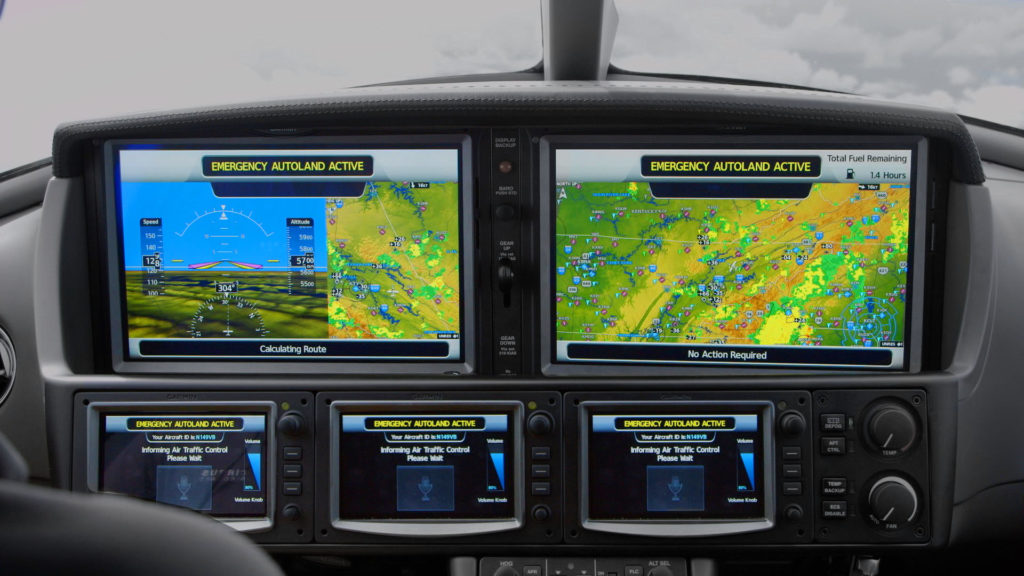
We are committed to building on the mission of bringing innovations to the industry, furthering the vision of Wilbur and Orville Wright, whose resolve and commitment to heavier-than-air flight sparked the current-day modern transportation movement. Several significant accomplishments and innovations of previous Collier Trophy winners helped lay the groundwork for what is now Autoland, including: the Global Positioning System Team in 1992; the Radio Technical Commission for Aeronautics and the development of the modern-day ATC system in 1948; Elmer Sperry’s development of the initial autopilot building blocks; and William Lear’s development of the first jet autopilot in 1949. We believe this is only the beginning, as it continues to innovate and make advances to create new and exciting possibilities for air travel in the future.
The NAA is a non-profit, membership organization devoted to fostering America’s aerospace leadership and promoting public understanding of the importance of aviation and space flight to the United States. The NAA’s Collier Trophy Selection Committee will meet virtually in June and publicly announce the 2020 Collier Trophy award winner following their selection.
For additional information about Autoland and the Garmin Autonomi family of automated flight technologies, visit www.garmin.com/Autonomi.
1.See Garmin.com/ALuse for Autoland system requirements and limitations.
The post Garmin Autoland Named 2020 Finalist for Esteemed Robert J. Collier Trophy appeared first on Garmin Blog.
https://www.garmin.com/en-US/blog/aviation/garmin-autoland-named-2020-finalist-for-esteemed-robert-j-collier-trophy/
FLYING Magazine Honors Garmin Autoland with Editors’ Choice Award
FLYING Magazine honored our revolutionary Autoland system — part of our Garmin AutonomiTM family of autonomous safety-enhancing technologies — with a 2021 Editors’ Choice Award. Autoland is the world’s first certified system of its kind with the ability to activate during an emergency situation to autonomously control and land an aircraft without human intervention1.
Each year, FLYING’s Editors’ Choice Awards celebrate an elite collection of aircraft and products that demonstrate significant innovation and technological advancements. For 2021, FLYING chose to honor the collaboration between organizations in the efforts required to achieve certification well as highlighting the importance of working together to drive innovation forward for the industry.
“We are humbled to receive this award for Autoland from such a revered publication like FLYING,” said Carl Wolf, Garmin vice president aviation sales and marketing. “This award recognizes a decade’s worth of passion and dedication exhibited by the Garmin team who never stop innovating in ways that help make aviation safer. Even more, we are proud to receive this recognition along with our aircraft manufacturing collaborators Piper, DAHER, and Cirrus, who shared the same vision to bring this life- saving technology to the industry.”
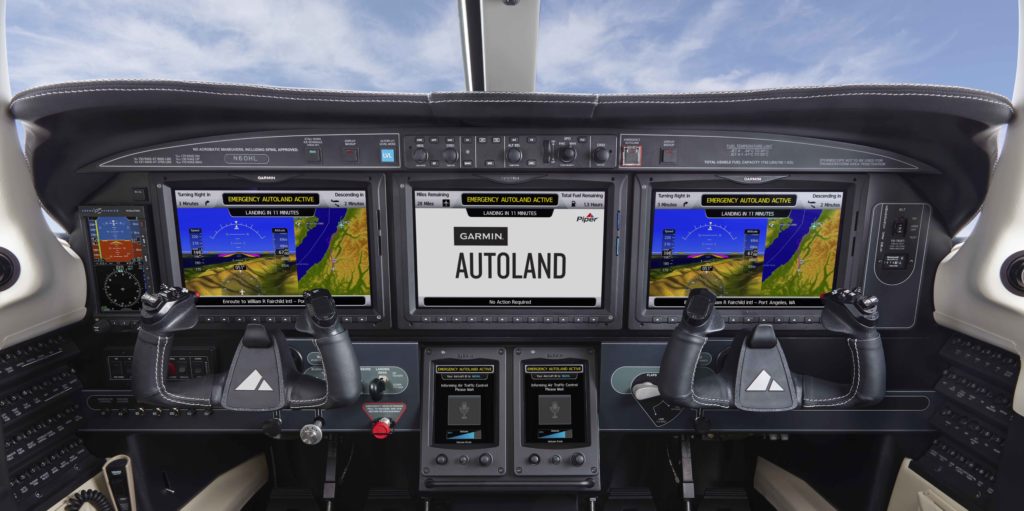
In the event of an emergency such as pilot incapacitation, the pilot or even a passenger on board can activate Autoland to land the aircraft with a simple press of a dedicated button. Autoland can also activate automatically if the system determines it’s necessary. Once activated, the system immediately calculates a flight path to the most suitable airport and runway, while avoiding terrain and adverse weather, initiates an approach and automatically lands the aircraft.
This year’s recipients of FLYING’s Editors’ Choice Awards will compete for the FLYING 2021 Innovation Award, an honor presented in conjunction with EAA AirVenture, July 26 through August 1, recognizing the most innovative product to have reached the business and general aviation market the previous year.
The first Autoland system for general aviation aircraft, Garmin Autoland has received Federal Aviation Administration (FAA) certification in the Piper M600, the Daher TBM 940, and the Cirrus Vision Jet as part of the G3000® integrated flight deck. European Union Aviation Safety Agency (EASA) approval was also granted to Daher with the TBM 940.
For additional information about Autoland and the Garmin AutonomiTM family of automated flight technologies, visit www.garmin.com/Autonomi.
The post FLYING Magazine Honors Garmin Autoland with Editors’ Choice Award appeared first on Garmin Blog.
https://www.garmin.com/en-US/blog/aviation/garmin-autoland-wins-flying-magazine-editors-choice-award/
Garmin Pilot Training Team Expands 2021 Opportunities
Our pilot training team is offering expanded pilot training opportunities for 2021, including virtual training options through June 2021 and plans for the resumption of in-person training starting in August. A variety of opportunities are available ranging from self-study materials, webinars, eLearning courses and instructor-led training offered for the GTN Series, G500/G600, G500/600/G700 TXi
Series, G500/G600, G500/600/G700 TXi , G3X Touch
, G3X Touch , and Garmin integrated flight decks. Our instructor-led courses provide pilots with a hands-on approach to learning Garmin avionics in a virtual or in-person classroom environment taught by a team of dedicated and experienced flight instructors.
, and Garmin integrated flight decks. Our instructor-led courses provide pilots with a hands-on approach to learning Garmin avionics in a virtual or in-person classroom environment taught by a team of dedicated and experienced flight instructors.
Professional instructor-led training
In the fall of 2021, our aviation training team intends to resume classroom training offered for all levels of experience at our headquarters in Olathe, Kansas assuming COVID-19 protocols can be safely followed. The health and safety of our customers and associates remains paramount to Garmin. We will continue to monitor the situation and communicate options to all registered attendees in advance if the current situation continues into the fall. To see the full calendar of training events and information on purchasing these classes, please visit www.fly.garmin.com/training.
- GTN Series: Explore the capabilities that Garmin’s GTN and GTN Xi series of navigators provides in this one-day virtual training class, or two-day in-person classroom training. This class is intended for both novice and experienced aviators using scenario-based training that builds on knowledge obtained through the GTN 2.0 eLearning course. The cost to attend the virtual GTN training class is $495, and the cost for the in-person classroom training is $550.
- GTN and Flight Display: This one-day virtual training class, or two-day in-person classroom training, includes instruction on the GTN/GTN Xi navigators and TXi series, G3X Touch and the G500/G600 displays. The training focuses on flight planning and instrument procedures for those that are both new to the GTN or just looking for a refresher, building on knowledge obtained through the GTN 2.0 eLearning course. The cost for the virtual training class is $625, and the cost for the in-person classroom training is $700.
- G1000®/G1000 NXi: With an emphasis on flight planning, instrument procedures, vertical navigation, and the automatic flight control system, this one-day instructor-led virtual training class, or two-day in-person classroom training, explores the vast capabilities of the G1000 integrated flight deck, building on knowledge obtained through G1000 NXi eLearning course. The cost for this virtual course is $700, and the cost for in-person classroom training is $825.
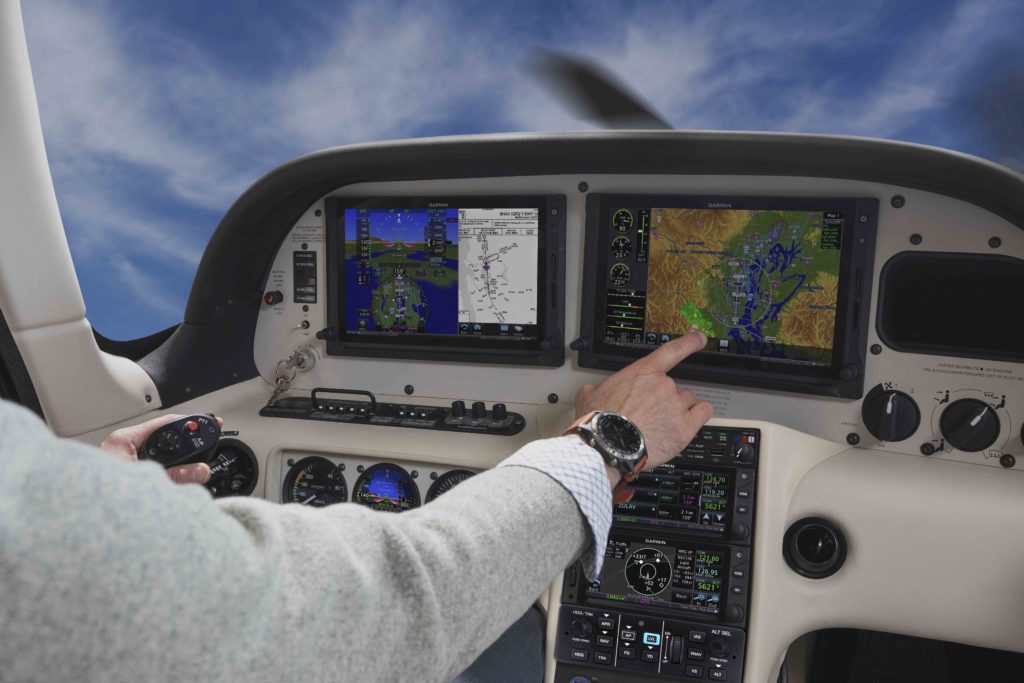
Take full advantage of Garmin avionics features and capabilities with eLearning Courses
Pilots can receive in-depth instruction to better prepare for flights through eLearning courses that guide them through scenarios intended to build understanding and confidence with Garmin avionics. Using a computer, tablet or smartphone, pilots can access the courseware immediately through the eLearning platform. Garmin eLearning courses come with a two-year subscription and can be purchased at www.fly.garmin.com/training.
The following eLearning opportunities are available:
- Garmin GTN Essentials 2.0: This course provides in-depth instruction on the fundamental operation of the highly capable GTN and GTN Xi touchscreen navigators, as well as helicopter features, for pilots that are new to the GTN or just want a refresher.
- Garmin TXi Essentials: For pilots that are new to the system, this course will provide instruction on fundamental operation of the touchscreen flight display.
- Garmin G1000 NXi: Pilots will have four comprehensive courses to choose from that will provide in-depth training on the G1000 NXi depending on the needs of the pilot to enable effective use of the system’s situational awareness and decision-making resources.
- Garmin G3000® Essentials: This eLearning course introduces pilots to the operation and user interface of the G3000 integrated flight deck.
- Garmin G5000® Essentials 2.0 and 2.0 PLUS: Introduces pilots to the operation and user interface of the G5000 integrated flight deck, including the latest features. The G5000 Essentials 2.0 PLUS course includes a separate module that describes autothrottle usage.
- Garmin Aviation Weather Radar 2.0: This course helps pilots understand the fundamentals of weather radar and the latest features to take full advantage of Garmin GWX
 systems.
systems.
Attend monthly one-hour webinars
These scenario-based webinars are offered monthly for no charge and are intended to help pilots explore various avionics setups, flight planning, navigation and other features with Garmin pilot instructors. Webinar options are updated monthly, so please be sure to check back frequently for the latest offerings. To register for Aviation Webinars, please visit Garmin.com/AviationWebinars.
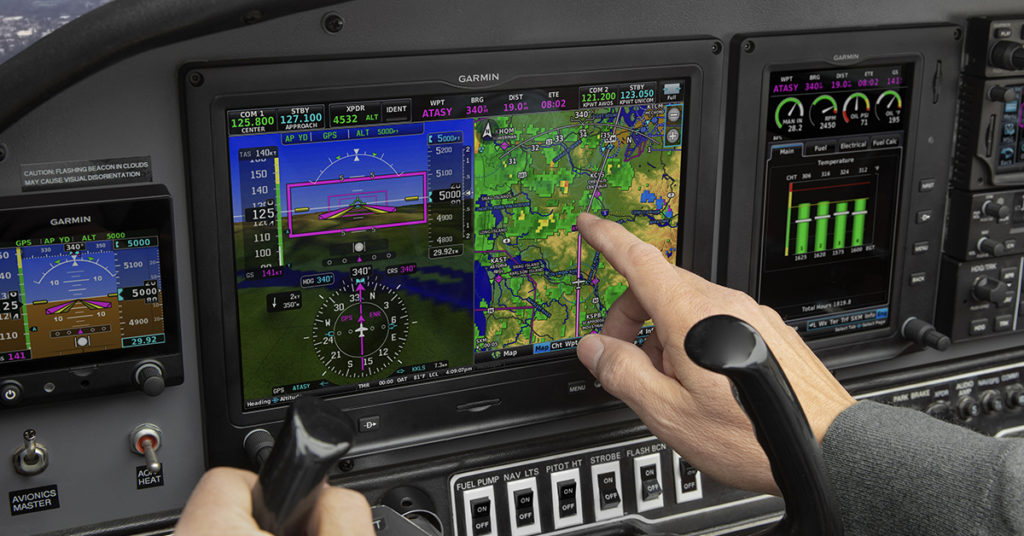
EAA AirVenture 2021
The Garmin Aviation Training team anticipates offering seminars and classes at EAA AirVenture. The team plans to provide two-hour GTN Series training seminars from July 26-30, focusing on what is most important to customers – flight planning and instrument approach procedures. We will also offer the G3X Touch Academy and other GTN pilot training seminars in the Garmin tents. As EAA AirVenture 2021 nears, visit flyGarmin.com/training to see the full and evolving list of training events and to registers for one of these classes.
Build a solid foundation with self-study opportunities
Detailed pilot guides provide extensive information on features, functions, and capabilities related to Garmin avionics that the pilot must know in order to operate the aircraft. Free pilot guides are available for download for all retrofit installations including the GTN series, GTN Xi series, G500/G600, G500/G600/G700 TXi, and G3X Touch. For integrated flight decks such as the G1000, G3000 and G5000, the pilot’s guides are available from the aircraft manufacturer. Training videos and pilot training webinar recordings can be found on the Garmin Aviation YouTube channel.
PC and iPad® Trainers
We also offers a limited number of computer (PC) and iPad trainers that simulate the behavior of an avionics system interface for pilots interested in learning the basic operation of a system. Current PC trainers can be found at www.Garmin.com, and the GTN, GTN Xi, and TXi series trainer apps are available for download from the Apple® App Store®.
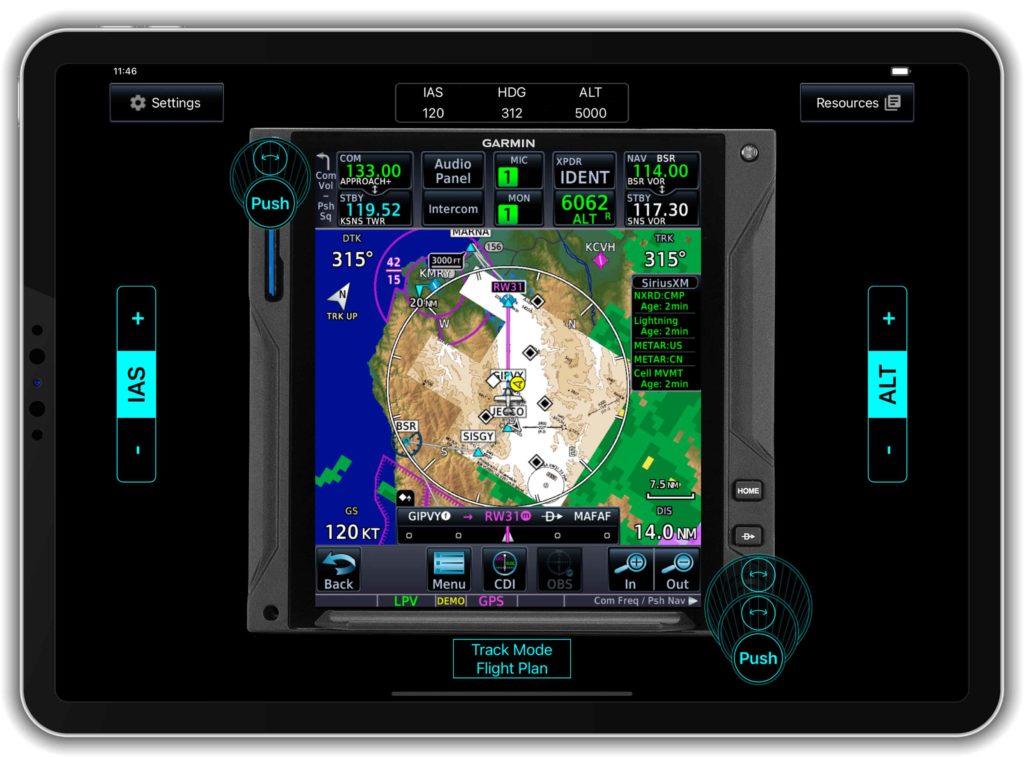
Custom Training Requests
The Garmin Aviation Training team can support on-demand training requests based upon instructor availability and training resource considerations on a first-come, first serve basis. For all Garmin aviation training needs, including reservations for one of these training events, please visit www.fly.garmin.com/training. For additional information, please contact aviation.training@garmin.com.
The post Garmin Pilot Training Team Expands 2021 Opportunities appeared first on Garmin Blog.
https://www.garmin.com/en-US/blog/aviation/garmin-pilot-training-team-expands-2021-opportunities/
Joby Aviation Selects G3000 for Revolutionary eVTOL Aircraft
The Garmin aviation team announced a long-term agreement to provide the state-of-the-art G3000® integrated flight deck to Joby Aviation for their revolutionary all-electric vertical takeoff and landing (eVTOL) aircraft, which is expected to commence commercial operations in 2024. Our decades of experience deploying certified avionics solutions to new markets continues with the touchscreen G3000 integrated flight deck for eVTOL aircraft in the Urban Air Mobility (UAM) market. The G3000 integrated flight deck has amassed extensive field service history, and with this derivation of the system into the eVTOL segment, it leverages that proven experience while offering advanced integration functionality in a compact design with unparalleled capabilities.
“Garmin has a remarkable track record of developing innovative and reliable products,” said Joby Aviation founder and CEO JoeBen Bevirt. “They are market leaders in this space and we’re proud to have their advanced technology onboard.”
“We are excited and proud of this strategic relationship with Joby Aviation to provide the advanced Garmin G3000 integrated flight deck for their revolutionary eVTOL aircraft,” said Phil Straub, Garmin executive vice president and managing director, aviation. “To be selected and trusted by Joby, an industry leader in this new market, is truly an honor. Garmin looks forward to continuing our extensive history of proven success in introducing innovative avionics technologies aligned with our vision for urban air mobility and the broader aviation industry. We are confident the G3000 will ultimately help Joby provide advanced, efficient, and scalable air taxi services for years to come.”
The modular G3000 integrated flight deck boasts light weight and vibrant high-resolution flight displays that support navigation, communication and flight sensor solutions and integrates seamlessly with Joby’s aircraft systems. Specifically tailored to meet the needs of eVTOL aircraft, the G3000 system that will be featured in Joby’s eVTOL aircraft delivers enhanced capabilities to optimize their air mobility service through tight integration with the vehicle mission computer and tailoring of flight guidance display indications. Further, the G3000 will be architected to provide the ability to efficiently facilitate future system upgrades as the Advanced Aerial Mobility (AAM) industry continues to evolve.
Joby Aviation is a California headquartered company developing an all-electric vertical takeoff and landing aircraft. After more than a decade of engineering and development, Joby intends to operate the aircraft as a fast, quiet and affordable air mobility service as early as 2024. The piloted, zero-emissions aircraft, will be capable of transporting four passengers up to 150 miles on a single charge, with a top cruising speed of 200 mph. It is designed to help reduce urban congestion and accelerate the shift to sustainable modes of transit. Designed for daily life, the aircraft lands vertically and provides flexibility and versatility to serve nearly any community.
The post Joby Aviation Selects G3000 for Revolutionary eVTOL Aircraft appeared first on Garmin Blog.
https://www.garmin.com/en-US/blog/aviation/joby-aviation-selects-g3000-for-revolutionary-evtol-aircraft/
Garmin GFC 600 Digital Autopilot Approved for Select King Air C90 and E90 Aircraft
Our GFC 600 digital autopilot has received FAA STC approval in select Beechcraft King Air C90 aircraft and E90 aircraft1. GFC 600 is optimized for turbine aircraft, delivering superior in-flight characteristics and new operational capabilities such as Vertical Navigation (VNAV), automatic Course Deviation Indicator (CDI) switching when paired with a GTN Series navigator, enhanced go-around capability and much more.
600 digital autopilot has received FAA STC approval in select Beechcraft King Air C90 aircraft and E90 aircraft1. GFC 600 is optimized for turbine aircraft, delivering superior in-flight characteristics and new operational capabilities such as Vertical Navigation (VNAV), automatic Course Deviation Indicator (CDI) switching when paired with a GTN Series navigator, enhanced go-around capability and much more.
The GFC 600 certification for the Beechcraft King Air C90 and E90 provides owners and operators an autopilot upgrade that boasts superior integration potential with G600 and G600 TXi flight displays, the GI 275 electronic flight instrument, as well as the GTN and GTN Xi Series of navigators. The self-contained autopilot controller incorporates backlit keys and a bright, sunlight readable display that depicts autopilot status and mode selection. An intuitive built-in control wheel also provides convenient adjustment of aircraft pitch, airspeed and vertical speed modes. When the level button is selected, the aircraft automatically returns to straight-and-level flight.

Environmentally hardened autopilot servos designed for harsh operating conditions contain brushless DC motors offering improved performance and reducing maintenance requirements when compared to decades-old servo designs on the market today. In addition, these servos are optimized for turbine aircraft by offering more torque to help better command and respond to control demands required of turbine aircraft.
Standard mark-width design of the GFC 600 mode controller ensures the autopilot controller allows for routine installation into the aircraft’s avionics stack. Autopilot mode annunciation is available on the G600 TXi touchscreen glass flight display, as well as the G600 flight display. The addition of an optional autopilot annunciator panel also displays the selected autopilot mode in the pilot’s primary field of view and retains an identical footprint of third-party autopilot annunciators on the market.
In addition to traditional autopilot capabilities such as altitude hold, vertical speed and heading modes, the GFC 600 also includes:
- Premium functions and advanced capabilities such as altitude pre-select2 and indicated airspeed hold mode
- Pilots can select, couple and fly various instrument approaches, including GPS, ILS, VOR, LOC and back course approaches3
- Built-in GPS roll steering capability eliminates the need for external roll steering converters, allowing for smoother navigation tracking when installed with a compatible navigator
- Level Mode button, which automatically engages the autopilot to restore the aircraft to straight and level flight
- Underspeed protection helps prevent the pilot from stalling the aircraft
- Overspeed protection helps prevent the pilot from exceeding aircraft maximum speed (VNE)
- Yaw Damping (YD) mode minimizes yawing oscillations while also helping to maintain coordinated flight
- Flight Director command bars can be displayed on flight display such as the G600 and G600 TXi
- Pilots can fly coupled ‘go-arounds’ during missed approach sequencing. A remotely-installed go-around button commands the Flight Director to display the appropriate pitch attitude required for the missed approach procedure and activates a loaded missed approach when paired with a GTN 650/750 or GTN 650Xi/750Xi navigator
- Included pitch-trim servo adds automatic trim and improved manual electric trim
- Control wheel steering is available, which allows the pilot to adjust pitch, roll, altitude hold, vertical speed or airspeed references using the control yoke while the autopilot is engaged
As a standard feature, pilots receive Garmin ESP with the GFC 600 autopilot, which works to assist the pilot in maintaining the aircraft in a stable flight condition. ESP functions independently of the autopilot and works in the background to help pilots avoid inadvertent flight attitudes or bank angles and provide airspeed protection while the pilot is hand-flying the aircraft.
The GFC 600 digital autopilot for the Beechcraft King Air C90/E90 is available immediately through select Garmin authorized dealers. To view the most up-to-date aircraft STC list, to view certifications that are expected to begin in the next 12-months, or to express interest in a specific aircraft make/model for the GFC 600, visit www.garmin.com/GFC600. For additional information, visit: www.garmin.com/aviation.
1. STC approved for Beechcraft King Air C90, C90-1, C90A, C90B, C90SE, C90GT, C90GTi, E90, and does not include those aircraft equipped with Garmin G1000/G1000 NXi, or Collins Pro Line integrated flight decks.
2. Available on GFC 600 or Garmin flight displays.
3. GFC 600 requires an external navigator for navigation and approach functions. See website for additional compatibility information.
The post Garmin GFC 600 Digital Autopilot Approved for Select King Air C90 and E90 Aircraft appeared first on Garmin Blog.
https://www.garmin.com/en-US/blog/aviation/garmin-gfc-600-digital-autopilot-approved-for-select-king-air-c90-and-e90-aircraft/
Airbus Helicopters Honors Garmin with Consecutive On-Time Delivery Awards
Airbus Helicopters, Inc. honored the Garmin aviation team with a 2020 On-Time Delivery Award from Airbus Helicopters, Inc. for its efficient performance related to product delivery. Garmin avionics are available as standard on select Airbus Helicopters, including the H125, H130, H135 and H145.
Each year, Airbus Helicopters, Inc. recognizes suppliers who stand out in performance, competitiveness and reliability. This is the second year in a row Garmin has won the On-Time Delivery Award for commitment and timeliness in delivering avionics to fulfill Airbus Helicopters Inc. production lines and customer orders.
“We are once again very proud to be recognized by Airbus with this prestigious award for our commitment to serve them and our mutual customers with the on-time delivery of our products,” said Carl Wolf, Garmin vice president aviation sales and marketing. “To again receive this award is truly humbling and ultimately would not be possible without the dedication of our entire Garmin team, in addition to the gratifying strategic relationship with Airbus Helicopters.”
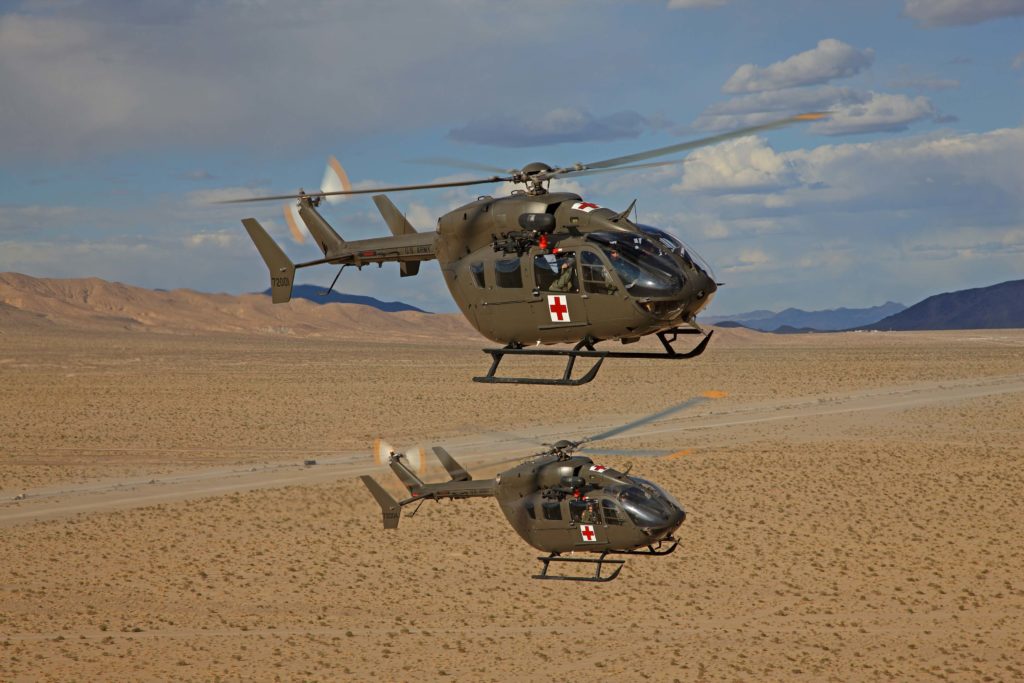
Garmin avionics are available as standard on the Airbus H125, including the G500H TXi flight display, GTN 650 touchscreen navigator, GNC 255 nav/comm, GMA 350c audio panel and the GTX 335R remote-mount ADS-B Out transponder. The GTN 750, GNC 255 and GTX 335R are also available as standard on the H130, while the H135/H145 feature the GTN 750 and Flight Stream 510 as standard equipment.
This marks the third consecutive year Garmin has received an award from Airbus Helicopters, Inc. In 2018, Garmin was also recognized by Airbus Helicopters, Inc. as the Supplier of Excellence for its unmatched responsiveness and competitiveness in its support of the UH-72A Lakota helicopter program, and for its overall support at the Airbus Helicopters Inc. finally assembly and completion center in Columbus, Miss.
The post Airbus Helicopters Honors Garmin with Consecutive On-Time Delivery Awards appeared first on Garmin Blog.
https://www.garmin.com/en-US/blog/aviation/airbus-helicopters-honors-garmin-with-consecutive-on-time-delivery-awards/
Garmin Receives Consecutive Supplier of the Year Awards from Embraer
Embraer awarded the Garmin aviation team with its 11th Supplier of the Year award in the past 10 years. The Supplier of the Year distinction was presented in the Electric and Electronic Systems category for the G3000® Prodigy Touch flight deck systems in the Phenom 100EV and Phenom 300E.
“We are honored to receive consecutive Supplier of the Year awards from Embraer,” said Carl Wolf, Garmin vice president of aviation sales and marketing. “These honors go beyond the product; they represent the strong collaboration between Garmin and Embraer resulting in a terrific in-flight experience for our mutual customers. It is truly rewarding and motivating for our employees to receive eleven Supplier of the Year awards over the ten-year period”
Embraer recognized a select group of elite suppliers for their outstanding performance in various categories. The 2019 Electric and Electronic Systems award recognizes design innovation, ease of use and overall system architecture, as well outstanding efforts in production line support, quality and on-time reliability of the supply chain. This award also distinguishes our commitment to design and manufacture state-of-the-art flight deck systems, while being responsive to market needs and preferences.
This is the 11th supplier award presented to Garmin by Embraer.
- 2019: Electric & Electronic Systems
- 2018: Electric & Electronic Systems
- 2017: Technical Support to Operator
- 2017: Electro – Electronic Systems
- 2016: Electro – Mechanical Systems
- 2015: Electro – Mechanical Systems
- 2015: Material Support to Operator
- 2014: Material Support to Operator
- 2011: Electro – Electronic Systems
- 2011: Technical Support to Operator
- 2010: Electro – Electronic Systems
Among hundreds of suppliers, best supplier recipients undergo stringent evaluation and are recognized as having shown outstanding performance, continuous improvement and increased customer satisfaction among all other suppliers in their respective categories. Nine award categories were presented among Embraer’s entire aircraft portfolio, including Executive Aviation, Defense, and Commercial Aircraft. Suppliers are considered based on several attributes, including innovation, delivery, quality, reliability, flexibility and customer support.
The post Garmin Receives Consecutive Supplier of the Year Awards from Embraer appeared first on Garmin Blog.
https://www.garmin.com/en-US/blog/aviation/garmin-receives-consecutive-supplier-of-the-year-awards-from-embraer/
More Effectively Manage Engines, Fuel with Garmin Engine Indication System
The benefits of digital engine indication systems (EIS) go far beyond replacing an aging system in your aircraft. These modern, reliable solutions can offer significant improvements over older, maintenance-prone analog instruments. They also can present crucial engine and fuel information with enhanced precision. Streamlined displays with intuitive user interfaces can help reduce pilot workload, improve engine and fuel management, and add overall confidence in the cockpit. Our broad range of EIS solutions were designed with these principles in mind. From our compact GI 275 EIS to our larger format EIS TXi and G3X Touch , we have an EIS solution for nearly every aircraft type and operator budget.
, we have an EIS solution for nearly every aircraft type and operator budget.
GI 275 EIS: Convenient size, powerful capabilities
Don’t be fooled by the size of our GI 275 EIS. Designed to fit a standard 3-1/8” instrument cutout, this stand-alone touchscreen solution provides engine, fuel, electrical information and more in a convenient, cost-effective package. Plus, with minimal or no panel modifications required for installation, GI 275 proves ideal for aircraft owners looking to keep the classic look of their panel. It graphically displays cylinder head and exhaust gas temperatures, features lean assist mode, and monitors fuel quantity and fuel flow to estimate how much fuel, range and flight time remains.
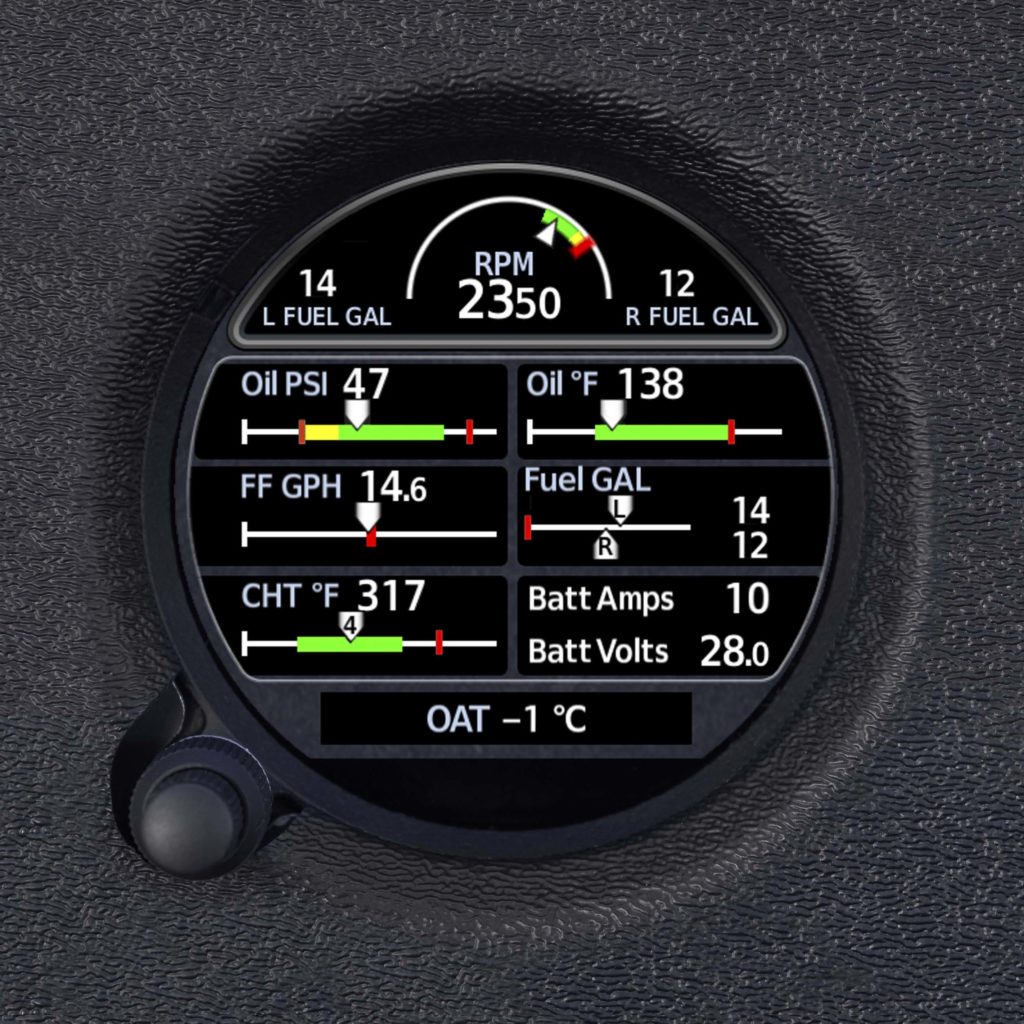
EIS TXi: Larger display, broader aircraft applicability
Looking for more display real estate to monitor engines and fuel? Our dedicated EIS TXi presents the same essential engine, fuel and electrical information as the GI 275 EIS but with a few more features on a larger touchscreen format – available in 7” landscape or 7” portrait options. It’s available for most normally aspirated or turbocharged Lycoming/Continental 4- to 6-cylinder singles and twins, as well as select single engine turboprop aircraft.
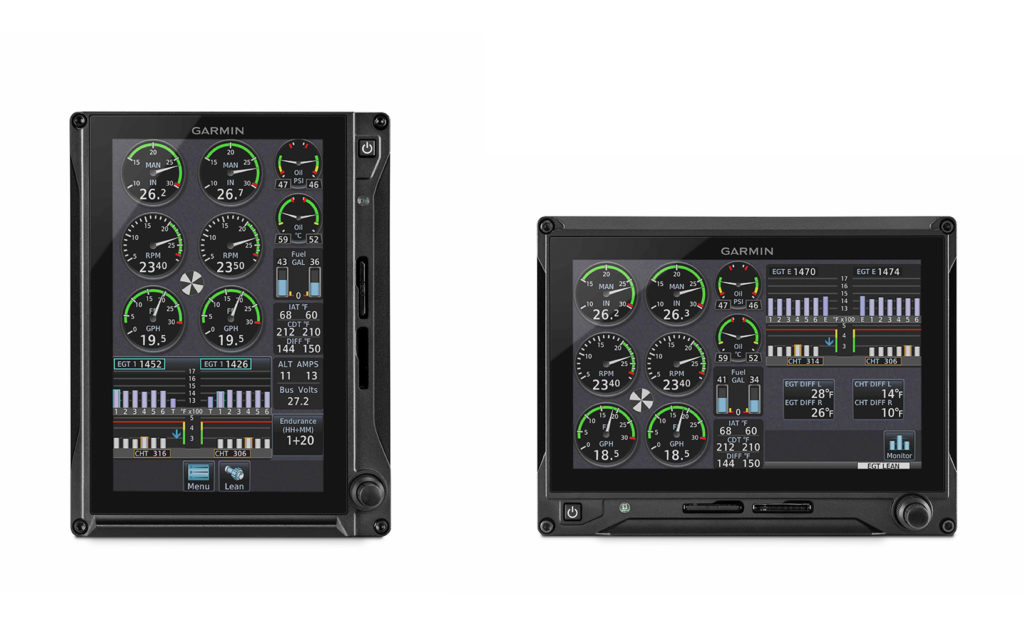
For turboprop operators, EIS TXi can display dynamic gauge range markings for torque, prop RPM, Ng percent, interstage turbine temperature and more. Automatic, color-coded data bands based on the aircraft’s current condition will illuminate, with automatic timers and exceedance warnings prompting visual cues to flash, highlighting each out-of-limit parameter.
Integrate EIS with PFD, MFD on G500/G600 TXi, G3X Touch
Some pilots prefer a panel layout with more integration and fewer displays. Our G500/G600 TXi and G3X Touch flight displays can combine EIS information with PFD and MFD capabilities in several sizes and configurations, providing an “all-in-one” flight display solution.
For panel upgrades with space for more than one display, both the TXi and G3X Touch series offer a stand-alone EIS/MFD combination. In this layout, available for single-engine piston aircraft, the EIS indications can be viewed in either an expanded format or a condensed strip on the touchscreen, allowing pilots to view MFD information next to the engine information. The opportunities TXi and G3X Touch offer to integrate allow expanded flexibility and functionality in individual displays.
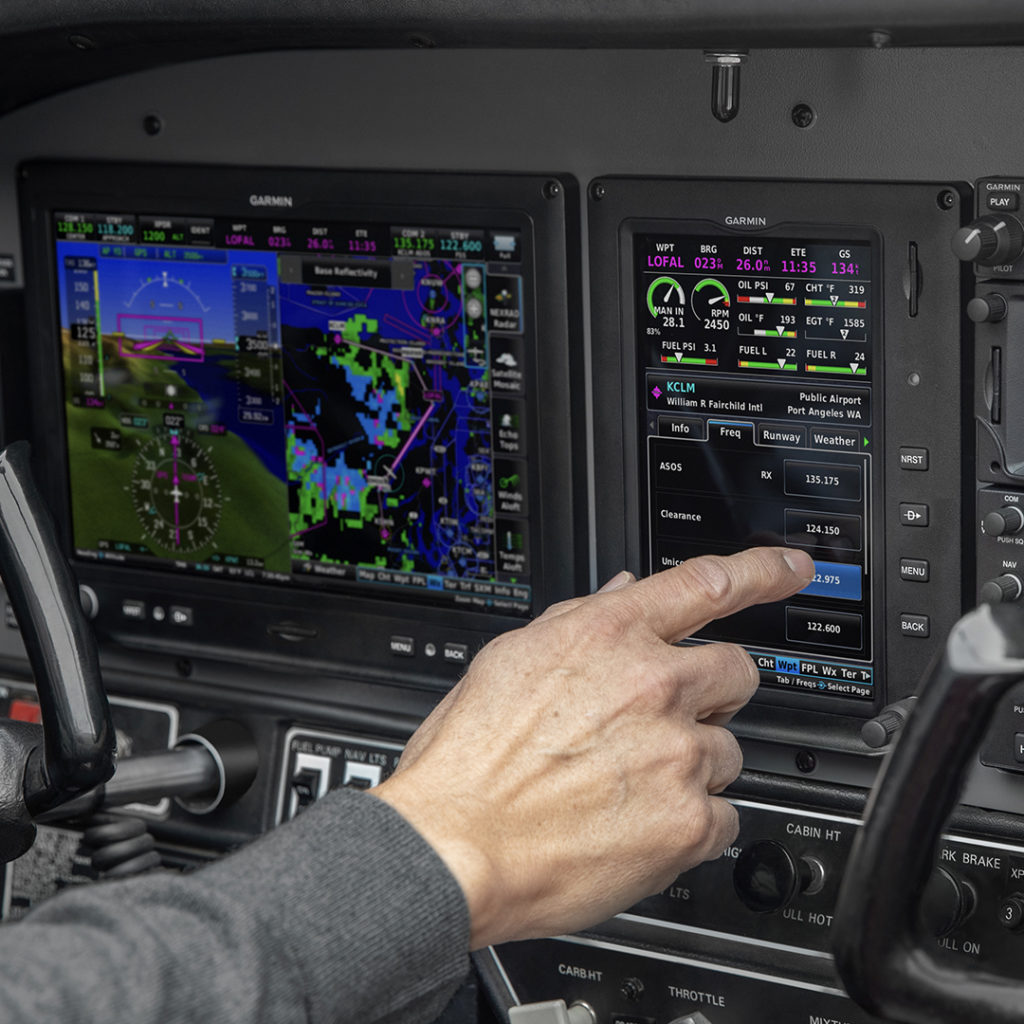
Customizable exceedance alerting and engine performance data logging
Predefined and pilot-selectable exceedance alerting comes standard with GI 275 EIS, EIS-capable TXi and G3X Touch flight displays. During installation, predefined limits are set for engine temperatures, oil pressure and more. After the install is completed, pilot-selectable alerts can be configured by operators to provide an extra level of protection. These pilot-selectable alerts are intended to signal the pilot before an exceedance is reached. Both predefined and pilot-selectable alerts prompt flashing cues, helping to identify potential out-of-limit exceedances and maintain long-term engine performance and overall health.
These EIS solutions can automatically log engine performance data for post-flight analysis. With the EIS-capable GI 275, data is automatically logged within the instrument, then can be wirelessly transmitted to a compatible mobile device downloaded with the Garmin Pilot app. Our G3X Touch displays log data to an SD
app. Our G3X Touch displays log data to an SD card installed in the display, which can be manually uploaded to flyGarmin.com or wirelessly transmitted to Garmin Pilot. EIS-equipped TXi displays automatically log engine data within the display too, and a Flight Stream 510 (sold separately) can wirelessly transmit EIS data to Garmin Pilot. In fact, engine performance data can be wirelessly transmitted to and displayed on Garmin Pilot in-flight. After landing, and engine data is transmitted to Garmin Pilot, it is automatically uploaded to flyGarmin.com and available for post-flight review. All information in flyGarmin.com is stored securely within our web-based cloud service.
card installed in the display, which can be manually uploaded to flyGarmin.com or wirelessly transmitted to Garmin Pilot. EIS-equipped TXi displays automatically log engine data within the display too, and a Flight Stream 510 (sold separately) can wirelessly transmit EIS data to Garmin Pilot. In fact, engine performance data can be wirelessly transmitted to and displayed on Garmin Pilot in-flight. After landing, and engine data is transmitted to Garmin Pilot, it is automatically uploaded to flyGarmin.com and available for post-flight review. All information in flyGarmin.com is stored securely within our web-based cloud service.
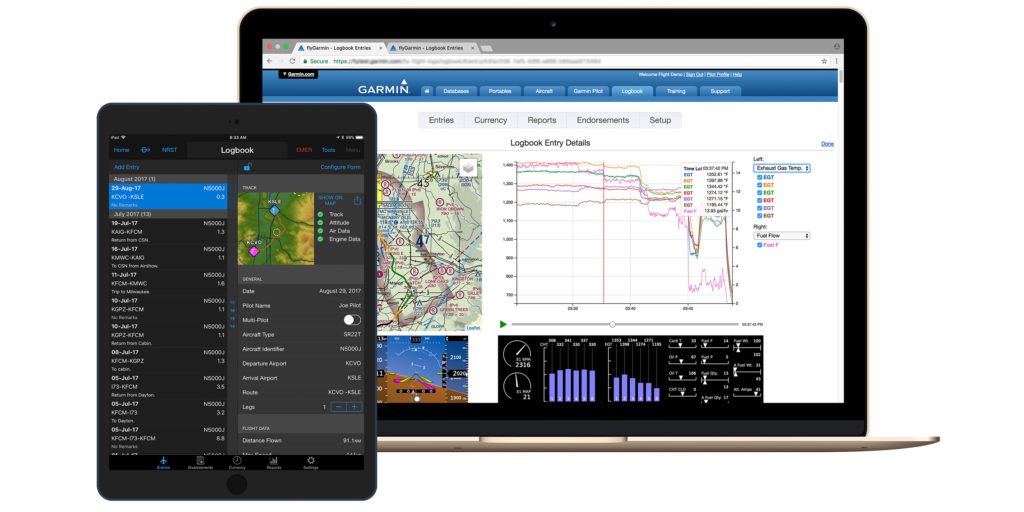
To learn more about all of our EIS solutions and latest avionics, visit Garmin.com/aviation.
The post More Effectively Manage Engines, Fuel with Garmin Engine Indication System appeared first on Garmin Blog.
https://www.garmin.com/en-US/blog/aviation/more-effectively-manage-engines-fuel-with-garmin-engine-indication-system/
New FltPlan.com AeroData Runway Analysis Service for Business Aviation Operators
Our FltPlan.com platform now features a new integrated runway analysis service from AeroData, allowing pilots to calculate performance data while creating a flight plan through FltPlan.com. AeroData runway analysis joins Aircraft Performance Group (APG) and Automated Systems in Aircraft Performance (ASAP) runway analysis services available from FltPlan.com. All three of these runway analysis offerings through FltPlan.com eliminate the need for pilots to reference manuals and perform their own manual calculations for takeoff and landing data, ultimately resulting in time savings and more accurate performance numbers. The tailored performance data allows crews to maximize the performance of the aircraft while also assuring compliance with runway and obstacle requirements. Additional features of the AeroData service include concise engine- out escape procedures that factor in obstacles and terrain, the ability to specifically configure Takeoff- and-Landing Data (TOLD) based on conditions and limitations, automatically calculate aircraft fuel requirements based on the flight plan, integration with Garmin PilotTM and much more.
“AeroData is the premier runway analysis provider for commercial air carriers in North America and Garmin is excited to integrate this service with FltPlan.com for use by our business aviation customers,” said Carl Wolf, Garmin vice president of aviation sales and marketing. “Pilots and operators now have the unique ability to calculate performance data and receive obstacle clearance while creating their flight plan on FltPlan.com – maximizing aircraft performance for the intended operation.”
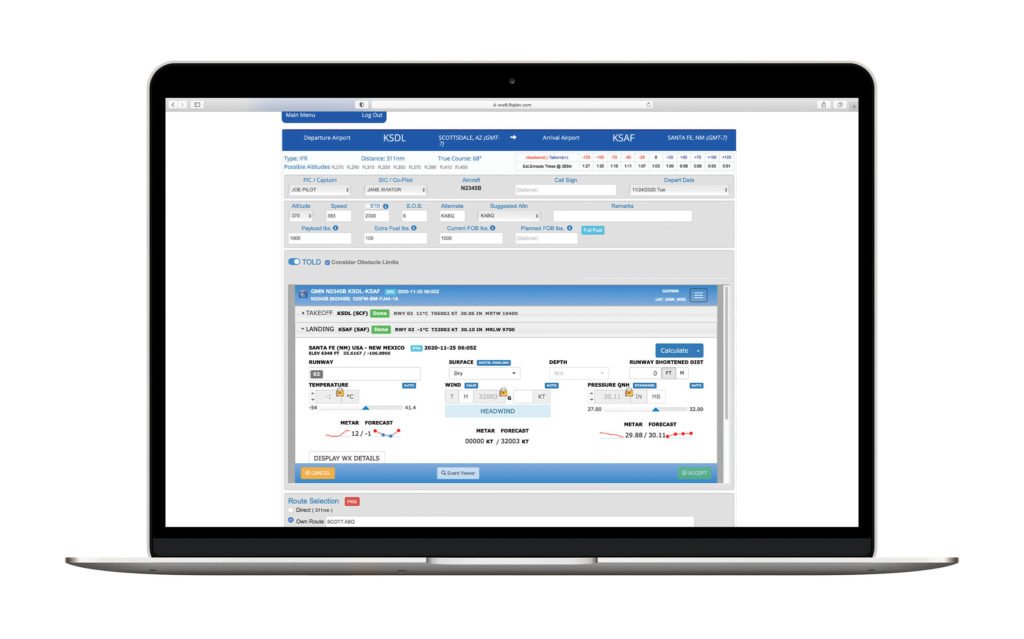
AeroData expands into business aviation
As one of the leading providers of runway analysis for commercial airlines, AeroData serves over 135 airlines globally and is the data provider for more than 70 percent of airline flights in North America. The integration with FltPlan.com brings AeroData, an experienced data provider, into business aviation, giving pilots the ability to include information and calculations directly in the flight planning stage, saving valuable time and helping to increase accuracy. The more accurate performance data allows operators to optimize loading based on the consideration of airfield and aircraft conditions and provides an engine failure procedure (EFP) based on a detailed analysis of obstacles and terrain in the airport environment.
TOLD calculations
FltPlan.com’s flight planning engine automatically selects a preferred runway and aircraft configuration based on current aircraft and airfield conditions, which include the use of the current METAR, or forecast for the time of departure. Further, crews can tailor additional configurations that include runway direction; surface contaminant; runway length; weather information such as winds, temperature, and altimeter setting; aircraft flap configuration; and Minimum Equipment List (MEL) penalties. Additionally, when an aircraft is performance limited by factors such as runway condition or climb gradient requirements, crews can adjust aircraft and airfield configurations to calculate performance numbers that would help maximize aircraft operation. Applicable NOTAM information is also actively monitored and is reflected in TOLD calculations.
Performance calculations automatically added to FltPlan.com NavLog
After TOLD calculations are complete, a Takeoff and Landing Report (TLR) is generated and added to the FltPlan.com NavLog for reference. The TLR displays comprehensive data such as takeoff reference speeds, flap settings, power settings, environmental control system (ECS), anti-ice settings, runway surface conditions including contaminant level, tailwind calculations, and Maximum Runway Takeoff Weight (MRTW) for each available runway on the airfield. To better understand factors driving performance, crews can review limiting factors on the TLR that include climb performance, field length, or obstacle clearance, to name a few.
Easily accessible in-flight through the NavLog, landing performance data is included on the TLR based on calculated enroute fuel burn. Landing data shows reference speed (VREF) and landing distance based on landing weight, flap settings, ECS and anti-ice configurations, as well as reported braking action. Both factored and unfactored landing distances are displayed as separate options.
Additionally, pilots have the ability to easily view the TLR on a portable electronic device within the Garmin Pilot and FltPlan Go apps. This integration appends the TLR to the FltPlan.com NavLog for a quick and convenient way to reference runway analysis information while in flight.
Fuel order information is also automatically generated when creating a flight plan. This convenient feature assists pilots in that they no longer have to manually calculate the required fuel load while the system also checks basic structural weight limits of the aircraft to ensure that limitations will not be exceeded.
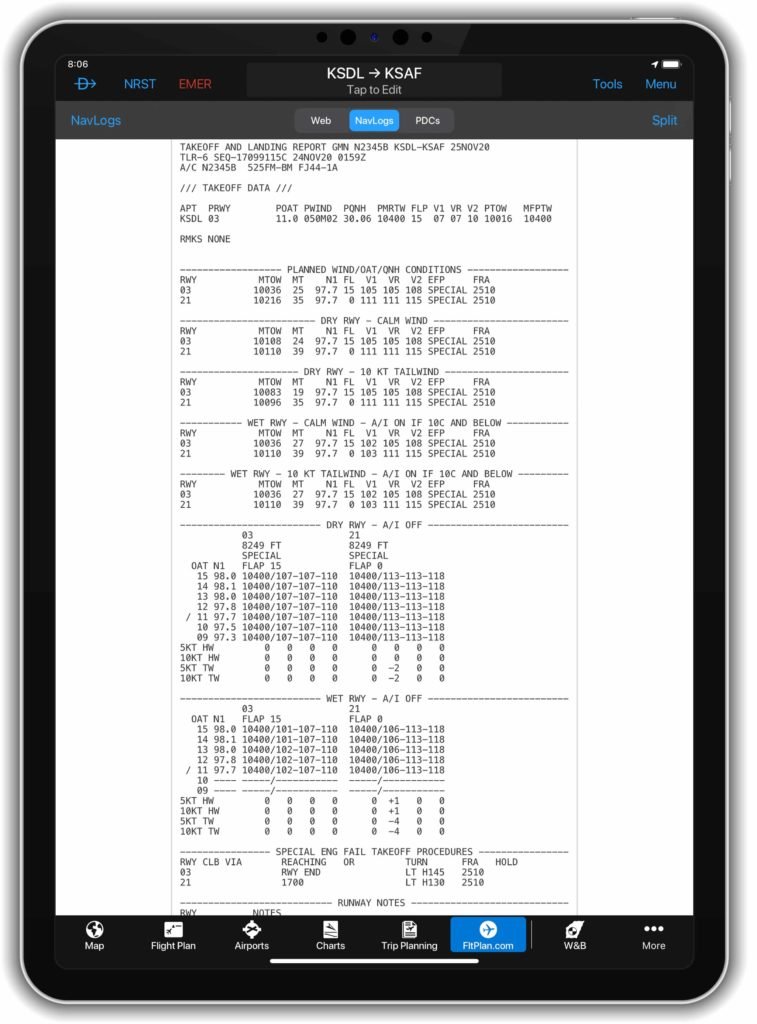
Engine Failure Procedures included in TLR
The TLR also uses calculated data to specify engine failure procedures (EFP) for each runway and aircraft configuration. When standard EFP’s cannot be used due to obstacle requirements, special procedures are calculated and provided on the TLR. Where terrain and obstacles limit straight out climb, AeroData designed EFP’s provide clear and concise guidance for pilots to perform a safe escape maneuver in a high workload flight environment.
AeroData Runway Analysis is available in two service options with one providing runway analysis, and another providing runway analysis plus obstacle clearance considerations. For more information on AeroData and runway analysis services, and to view supported aircraft, please visit www.FltPlan.com/Runway.htm.
The post New FltPlan.com AeroData Runway Analysis Service for Business Aviation Operators appeared first on Garmin Blog.
https://www.garmin.com/en-US/blog/aviation/new-fltplan-com-aerodata-runway-analysis-service-for-business-aviation-operators/
Smart Rudder Bias: Safety-Enhancing Technology for Select Twin-Engine Piston Aircraft
Our GFCTM 600 digital autopilot has been upgraded to feature new safety-enhancing capabilities, including Smart Rudder Bias for select piston twin-engine aircraft. Part of our AutonomiTM family of automated flight technologies, Smart Rudder Bias provides additional assistance against hazardous effects of a one-engine inoperative (OEI) event when appropriately equipped. It also provides pilots assistance in maintaining control of the aircraft while determining the next course of action, simultaneously reducing workload in a high-stress and time-critical flight environment.
“We are proud to be able to offer a new safety tool for twin-engine piston aircraft with the introduction of Smart Rudder Bias, making the GFC 600 digital autopilot the most advanced solution for this class of aircraft on the market today” said Carl Wolf, Garmin vice president of aviation sales and marketing. “With the introduction of Smart Rudder Bias technology, working together with the other Garmin systems onboard, pilots can react to an engine failure by quickly and accurately detecting the issue while simultaneously receiving automatic assistance applying the correct flight control input – providing an additional safety tool not seen before in twin-engine piston aircraft.”
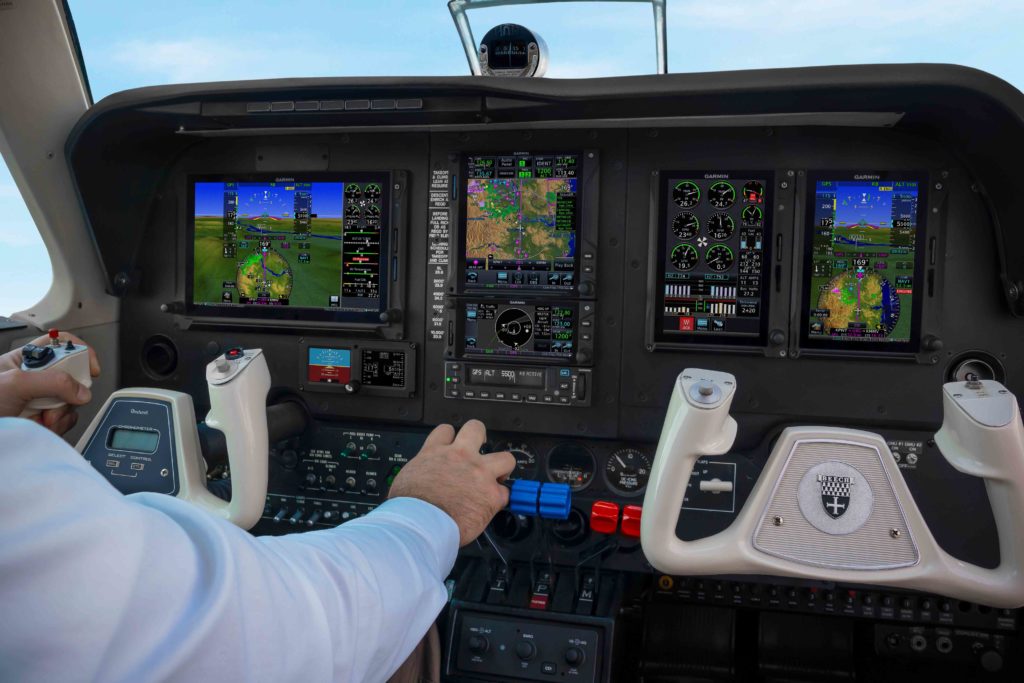
Help manage aerodynamic performance with Smart Rudder Bias
Twin-engine aircraft inherently have aircraft controllability concerns in the event of an engine failure and pilots can expect a significant yaw toward the inoperative engine, resulting in an unstable aircraft state. In addition, due to a sideslip condition and a windmilling propeller, there can be decreased lift on the wing associated with the inoperative engine and simultaneously an increase in drag, all factors contributing to degraded performance and a critical loss in airspeed. Through close integration with multiple onboard Garmin systems, Smart Rudder Bias helps address these major concerns and immediately assists with controllability issues. This gives the pilot time to take the correct action required in order to better maintain positive aircraft control and help keep the aircraft in a safe flight condition.
Positively identify inoperative engine quicker
When the aircraft reaches the manufacturer’s published minimum control speed (VMC) during the takeoff roll, Smart Rudder Bias is automatically armed. Smart Rudder Bias continuously monitors engine parameters using Engine Indication System (EIS) data displayed on a G500 TXi or G600 TXi flight display and activates when the system detects a predetermined power differential between each engine. Once activated, rudder force is dynamically adjusted to aid a pilot in providing enough force to the rudder to help control a sideslip. A yellow annunciator for the associated inoperative engine is conveniently displayed along with autopilot annunciations on the G500 TXi or G600 TXi flight display, helping the pilot identify the issue quicker. Smart Rudder Bias can be deactivated via a panel-mounted switch.
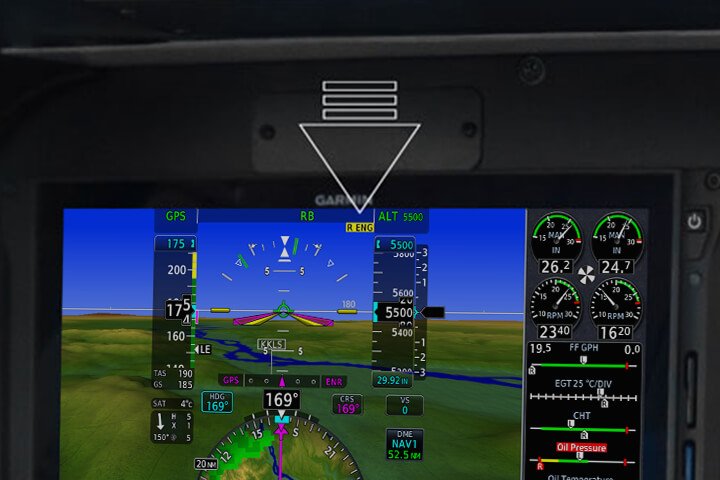
Smart Rudder Bias enhances ESP settings for OEI condition
Garmin’s Electronic Stability and Protection (ESPTM) functions independently of the autopilot, working in the background to help pilots avoid inadvertent flight attitudes or bank angles and provides airspeed protection while the pilot is hand-flying the aircraft. Smart Rudder Bias applies enhanced ESP settings tailored to engine-out flight. Roll protection is modified to help correct for the roll tendency caused by the inoperative engine, while underspeed protection activates at a higher airspeed to help keep the aircraft away from the critical VMC speed and the associated loss of positive aircraft control.
PA-31 certified with GFC 600 – optional yaw trim also available
The GFC 600 is also now certified on select Piper PA-31 aircraft, and an automatic yaw trim option is available. Similar to pitch trim, yaw trim allows for manual rudder trim control with the press of a button, and automatic control of the rudder trim when the GFC 600 autopilot or yaw damper is engaged.
Smart Rudder Bias requires a G500 TXi or G600 TXi configured as a primary flight display (PFD) with EIS, which can be shown as a strip on the G500 TXi or G600 TXi, or on a separate TXi display. Additionally, a GFC 600 digital autopilot with the yaw axis option must be installed. Initial certified aircraft with Smart Rudder Bias capability include the Beechcraft Baron 58 and 58A, as well as the Piper PA-31-300, PA-31-310, PA-31-325, and PA-31-325CR. Additional certifications of Smart Rudder Bias will be forthcoming.
For additional information about Smart Rudder Bias and the Garmin Autonomi family of automated flight technologies, visit www.Garmin.com/SmartRudderBias.
The post Smart Rudder Bias: Safety-Enhancing Technology for Select Twin-Engine Piston Aircraft appeared first on Garmin Blog.
https://www.garmin.com/en-US/blog/aviation/smart-rudder-bias-safety-enhancing-technology-for-select-twin-engine-piston-aircraft/
